The de Havilland Tiger Moth is one of the best-known British aircraft of all time. Malcolm V Lowe recounts the history and importance of this iconic biplane.

Above: Taken in June 1940, this image shows Hatfield-built DH.82A Tiger Moth R5130 going through its paces. The yellow undersides can be clearly seen, as can the tailskid, which was standard for British-built Tiger Moths. Key Collection.
Established by Geoffrey de Havilland during September 1920, the de Havilland Aircraft Company Ltd grew to become one of the largest designers and manufacturers of light aircraft the world has ever seen.
From humble beginnings the company expanded on the back of several successful designs, notably the Tiger Moth, into a major supplier of training aircraft when World War Two broke out in September 1939. During the war, de Havilland also produced the twin-engined Mosquito.
Famous products
The Tiger Moth could date its ancestry directly to de Havilland’s DH.60 Moth of the 1920s. The original DH.60 flew during February 1925, the first of what would become a successful family of designs. These included the Gipsy Moth, one of which was flown solo by pioneering female pilot Amy Johnson from England to Australia in 1930. However, a military trainer derivative of this type, with tandem-seating, failed to gain sufficient interest from Britain’s Air Ministry to supplant the already favoured Avro Tutor biplane.
Mindful of the potential for military orders, de Havilland duly altered the type’s design. In particular, the DH.60 trainer had a ‘straight’ upper wing almost directly above the front cockpit, making exiting from the forward seat with a parachute difficult.
The format was subsequently changed to an upper wing mounted further forward, but with its outer panels swept backwards to maintain the aerodynamic integrity of the design. The lower wings were also swept back at a slightly different angle.

Above: The RAF Central Flying School was one of many RAF training organisations that flew Tiger Moths. The five aircraft in this formation from the school’s aerobatic team really are flying inverted. Malcolm V Lowe Collection.
Together with a general ‘beefing up’ of the airframe, and better access by means of downwards-opening doors on each side for both cockpits, this simple but effective solution gained favour with the British authorities. As the DH.82, the design was adopted under an official Specification which called for a new ‘ab initio’ basic trainer for the RAF. The name Tiger Moth was duly accepted and, under Specification T.23/31, initial production went ahead of the very first military DH.82s. The actual debut airframe of this line was a prototype numbered E 6 (G-ABRC), which made its maiden flight on October 26, 1931, with Hubert Broad at the controls. The first production example received the British military serial number K2567 and was the start of a very long line of military Tiger Moths.
Initial airframes for the RAF were powered by the de Havilland Gipsy III piston engine (Tiger Moth Mk.I), but production soon switched to the Gipsy Major I powerplant (Tiger Moth Mk.II). The first production aircraft with this engine was G-ACDA. The designation DH.82A was allocated to the new layout (initially produced under Specification T.26/33) and, in this configuration, the Tiger Moth was an immediate success. The fact that Britain’s military had now bought the type gave the aircraft immediate appeal to other potential buyers, and it would gain orders worldwide for military and civil use. This also included licence production in other countries.
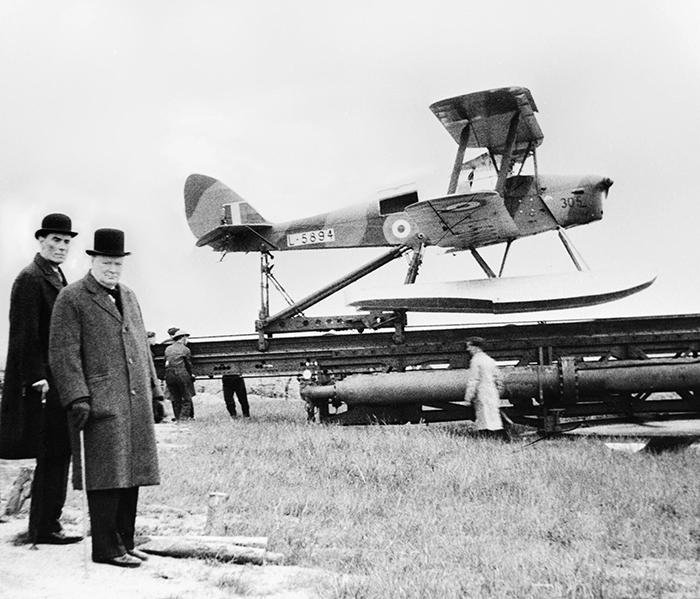
Above: A float-equipped Queen Bee (serial number L5894) mounted on its catapult, being inspected by Winston Churchill. The photo is dated June 1941. Malcolm V Lowe Collection.
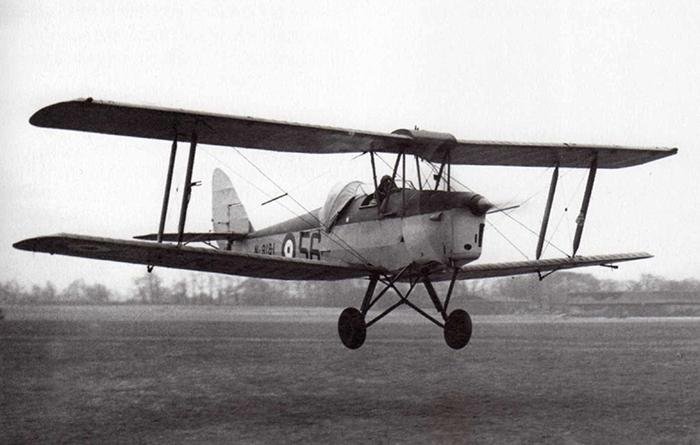
Above: As a part of the pilot training curriculum, Tiger Moths were fitted with a collapsible ‘blind-flying hood’ for the pupil in the rear cockpit, demonstrated here by an aircraft of 10 EFTS at RAF Yatesbury during 1940. Malcolm V Lowe Collection.
The classic DH.82A Tiger Moth was powered by a de Havilland Gipsy Major I inverted inline engine of 130hp (97kW). This gave a very stately maximum speed of 109mph (175km/h) at 1,000ft (305m). The upper wingspan was 29ft 4in (8.94 m) and the wings were made of fabric-covered wood, while the fuselage was based on a welded tubular steel framework, covered in fabric but with plywood decking behind the rear cockpit. An important modification that was made to service machines was the introduction of ‘anti-spin’ strakes on each side of the rear fuselage, just ahead of the horizontal tail.
Production of the Tiger Moth was undertaken initially by de Havilland at Stag Lane Aerodrome in Edgware, on the outskirts of north London. The company’s success resulted in a move to more expansive facilities at Hatfield, Hertfordshire, where the majority of de Havilland-built Tiger Moths were constructed. However, wartime demands, especially with the development of the Mosquito, resulted in manufacture being switched from de Havilland to Morris Motors Ltd at Cowley, Oxford, during 1941. Morris built the majority of British-produced Tiger Moths, its records stating that more than 3,400 examples were manufactured by the end of production in 1945.
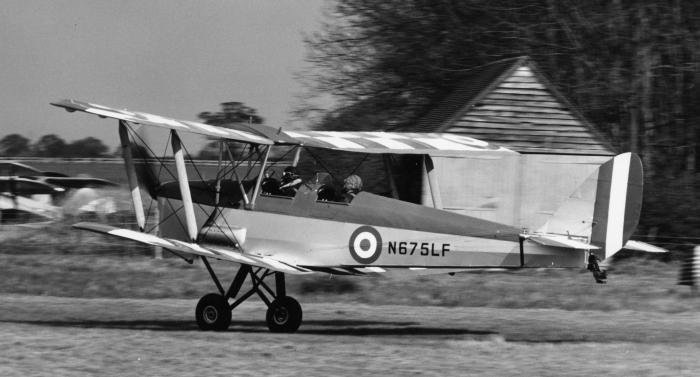
Above: Recently residing at Santa Paula airfield in California, Tiger Moth N675LF (and painted as G-ADNV) previously wore the colours of the RAF’s Central Flying School’s aerobatic team while in private ownership. Key Collection.
Radio control
An unusual spin-off from the Tiger Moth line was the de Havilland Queen Bee. This was basically an unmanned airframe converted into a target drone. Remote piloting from the ground was by means of radio control. It was a true predecessor of today’s unmanned aerial vehicles and drones, and was a successful, albeit rather expensive, way to train gunners. The type utilised the Tiger Moth’s engine and wooden wings, together with a wooden fuselage closely allied to the DH.60 Moth Major. Queen Bees could be fitted with either a normal land-based undercarriage or floats. The latter were catapult-launched, some actually being flown from warships. More than 400 examples were built.
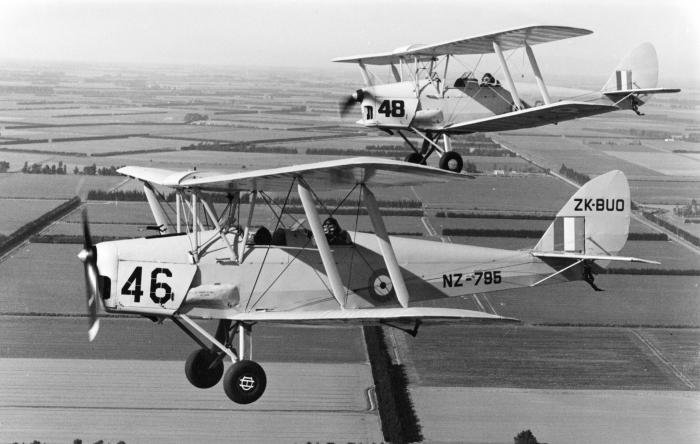
Above: Illustrating the worldwide nature of Tiger Moth manufacture and operations, this example, ZK-BUO/NZ-795 was built in New Zealand. At one time it flew with enclosed cockpits. Key Collection.
British service
The Tiger Moth entered RAF service very soon after the initial aircraft flew in October 1931. The following month, the first six production examples, with Gipsy III engines, were flown from Stag Lane to RAF Grantham in Lincolnshire for use by 3 Flying Training School (FTS). The type increasingly took over the basic training role for the RAF, but de Havilland also operated its own flying school at Hatfield. This and other private institutions in Britain were a part of the RAF’s reserve organisation, and eventually a system of Elementary and Reserve Flying Training Schools (ERFTS) was established in the 1930s. These were incorporated into ‘official’ Elementary Flying Training Schools (EFTS) during early World War Two.
In addition to aircrew training, some Tiger Moths were delegated to patrol and surveillance duties with the RAF’s Coastal Command due to a lack of more suitable types in the early war period. A scheme also existed within Operation Banquet to use Tiger Moths as last-ditch very light bombers if a German invasion had actually taken place, dropping small bombs on invading forces, but this never became necessary.
Post-war, the Tiger Moth continued in RAF service, some aircraft being flown by the RAF Volunteer Reserve, while others were operated in a number of University Air Squadrons. It was not until the first half of the 1950s that the de Havilland Canada DHC-1 Chipmunk (Chipmunk T.10) started to replace the type.
However, this was nowhere near the end of the Tiger Moth’s military service. The Royal Navy’s Fleet Air Arm was also an important operator of the type for land-based training and fleet requirements, having flown them during and after World War Two. It took delivery of a ‘new’ batch of Tiger Moths during the 1950s, which served well into the following decade. In 1964, four of these later examples became the last biplanes ever to land on and take off from an aircraft carrier, when they visited HMS Eagle during its working-up following a major refit at Devonport, Plymouth.
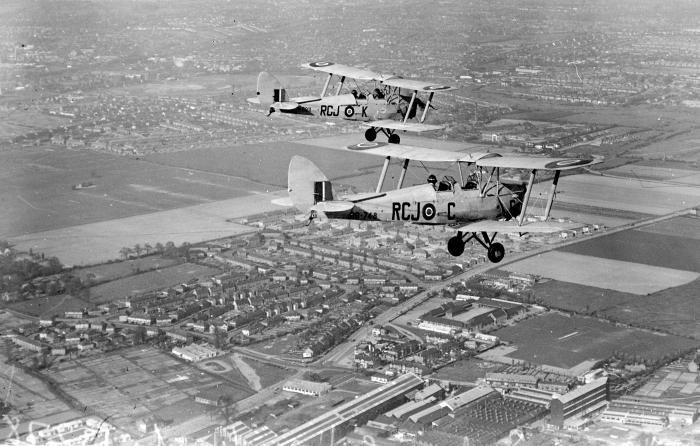
Above: RAF Hornchurch was home to RAF Flying Training Command’s Aircrew Selection Centre post-war. These two Tiger Moths, wearing the code of 17 RFS (Reserve Flying School), are seen flying over the Hornchurch area in an image dated April 1949. Key Collection.
Training needs
Set up under the Riverdale Agreement of December 1939, a major scheme was created for the training of British and Commonwealth flyers for wartime service, as well those of other allied countries. Located principally in Canada, what is generally known as the British Commonwealth Air Training Plan or the Empire Air Training Scheme needed aircraft for the thousands of trainees. One of those selected was the ubiquitous Tiger Moth. Indeed, some consider its wartime role as a trainer around the world as the type’s finest hour, used not just by student pilots but other aircrew, including radio operators.
An important offshoot of the British-based concern was de Havilland Aircraft of Canada Ltd, which was established during 1928. This company became involved in Tiger Moth production due to wartime necessity, building airframes for training purposes in Canada itself. Following an initial batch of standard examples, the company built Tiger Moths with the designation DH.82C. These were significantly different to their British counterparts by having an enclosed, heated cabin with sliding transparent panels. They also featured brakes, a tailwheel rather than the standard skid, and metal struts. Some examples were fitted with a ski undercarriage to allow training to continue through the harsh Canadian winter. Due to shortages of Gipsy Major engines, some were fitted with the Menasco D-4 Super Pirate 125hp (93kW) inline engine.
US involvement
It is a little-known fact that the United States also played a part in the military Tiger Moth story. In total, 200 airframes were paid for by the US government under Lend-Lease provisions, for employment in Canada as trainers. They received the designation PT-24-DH, the ‘DH’ standing for de Havilland Canada, which built them. They were not used by the US Army Air Forces but were flown by the Royal Canadian Air Force (RCAF), although they received the US military serial numbers 42-964 to 42-1163. Their RCAF identities were 1100 to 1299. In RCAF service, they were designated as DH.82C Tiger Moths. Some of these aircraft survived the war and later passed into private ownership.
A small number of British-built examples were flown in England by the US Eighth Air Force on so-called ‘Reverse Lend-Lease’.
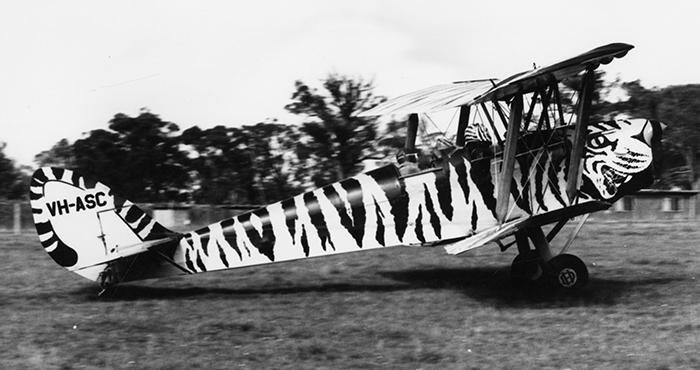
Above: An appropriately painted Tiger Moth, Australian-registered VH-ASC, bearing impressive striped ‘camouflage’. This aircraft also flew as the ‘Red Baron Tiger Moth’ for several years. Key Collection.

Above: Tiger Moths have featured in various movies and TV dramas, usually modified or painted to represent a completely different aircraft type. This is G-AIRK finished in fake German World War One livery with dummy machine guns fitted.
Many uses
In addition to the Tiger Moth’s main roles as a military trainer and privately owned civil aircraft, the type has been employed for many other tasks. In post-war Britain, it was a pioneer of agricultural aviation. From the late 1950s, a company named Farm Aviation used a fleet of specially converted Tiger Moths for crop-spraying. Tiger Moths have also appeared in many movies and TV dramas.
The exact number of Tiger Moths built is open to debate. Some experts claim 8,868 examples were constructed worldwide, although a total of 8,611 now seems to be generally accepted, excluding the unmanned Queen Bees.

Above: DH.82A Tiger Moth L6923 sails serenely above the clouds in this evocative photograph that illustrates the salient features of the type. When flown solo, Tiger Moths were – and still are – controlled from the rear cockpit. Key Collection.

Above: The Royal Australian Air Force (RAAF) was a significant user of Tiger Moths – A17-734 is seen in this post-war view displaying its silver doped finish. It was built by de Havilland Australia as DHA1065 and was later civil-registered as VH-SAC. RAAF.
Related types
The success of the Tiger Moth led to a number of spin-offs from the original design, in addition to alterations made in Canada for use there. The de Havilland company developed a passenger-carrying type roughly concurrent with the Tiger Moth, called the DH.83 Fox Moth. Featuring a redesigned fuselage with an open cockpit for the pilot to the rear of enclosed seating for up to four passengers, the type first flew in January 1932. It was a success, with just over 150 being built in Britain and Canada before and after World War Two. Unlike the Tiger Moth, the basically straight wings could be folded.
An important post-World War Two development was the Thruxton Jackaroo — a basic Tiger Moth with a modified and widened fuselage that could seat up to four under an enclosed canopy. The upper wingspan was also increased; only 19 were converted.
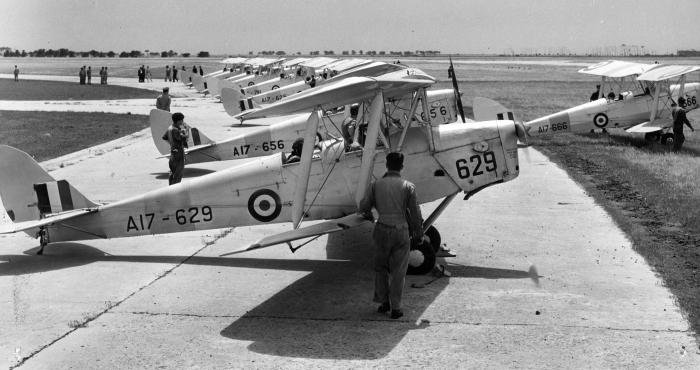
Above: A smart line-up of RAAF Tiger Moths; ‘A17’ was the RAAF code prefix for the Tiger Moth in Australian service. The nearest airframe (A17-629) was originally built for South African Air Force service but flew with the RAAF instead. Key Collection.
Well liked
The Tiger Moth became a highly sought-after private aircraft in the decades following World War Two and is as popular now as it ever was. A fully restored Tiger Moth can fetch between £40,000 to more than £50,000 nowadays, a far cry from its original cost of £1045. Many Tiger Moths are exhibited in aviation museums or are available for historic flights.
Even in our own time the Tiger Moth has a very practical use. For pilots accustomed to modern tricycle undercarriages who wish to transition to a tailwheel aircraft, perhaps a ‘warbird’ for display purposes, a Tiger Moth is ideal for providing useful basic training on that specific configuration.

